Jenny Gross graduated from Cuba High School, went to Fontbonne University, got a degree in Communication Arts/Public Relations, and now lives in the Lindenwood Neighborhood of South St. Louis City. Despite the degree in PR, she worked in purchasing for manufacturing companies. She has a photography business Simple Images. She is developing a web site simpleimagesbyjg.com, where you will be able to purchase her nature and landscape photos. Since her parents Willa and Art Gross still live in Cuba, she is a frequent visitor to the Rt. 66 Mural City.
I saw Jenny’s photography on Facebook and asked her to take photos of the murals when she was in Cuba and do a guest blog. Since I use to be Jenny’s teacher, it was just like old times. I gave her work to do, and she did it. She’s right, it is a challenge to take mural photos that are a little different from what you have seen before. That’s why you will see Viva Cuba blog photos of the murals with cars, people, frames, wreaths, etc at various times. Jenny rose to the challenge with her photographer’s eye, and the results are below. She also gives you her viewpoint about the assignment. Enjoy.
*************
From Jenny Gross…
On a recent trip home I walked around town taking photos of the murals. I won’t lie I was doing it because Mrs. Reed asked me to, or rather challenged me to. I don’t think she realized it was a challenge, but her comment, “make them artsy” was definitely a challenge for me. You see I’ve seen numerous photos of the murals, and I wasn’t sure how mine could be any different. Let’s face it, they’re very large, awesome pieces of art and to appreciate them you have to see the entire picture…. or do you?
In front of the five Civil War murals I began wondering how I would capture the scene. As I stood there procrastinating I started looking at the people. In all the years I’ve driven past these murals I never once looked beyond the entire work. What I found were numerous animated characters. With this revelation came questions. Did the artist knowingly fill these canvases with so many different emotions? Are the emotions I’m seeing those he meant to portray? Have other people noticed this too? Do they see the same things I do? I guess there’s only one way to find out. I’ll just ask.

In the mural ‘Destroying the Fort’ is the young soldier as calm he appears amongst his horse's fear and the chaos around him?
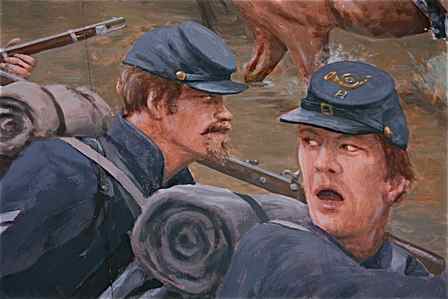
"Battle of the Huzzah’" leaves me wondering about the curiosity of one soldier and the determination of another. Does the man not looking back want to know how close the Confederate soldiers are?
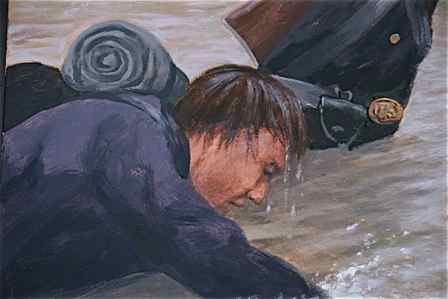
Also in "Battle of the Huzzah” will this soldier’s desperation to get out of the river overpower his exhaustion?
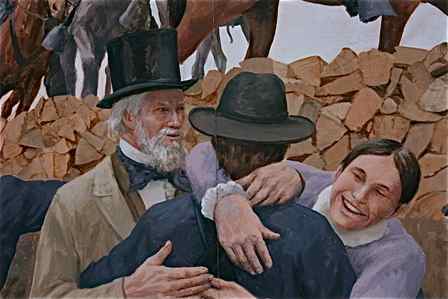
In “Rescue at Leasburg” I first wondered why these civilians were there. Is it possible they’re having a joyous family reunion?
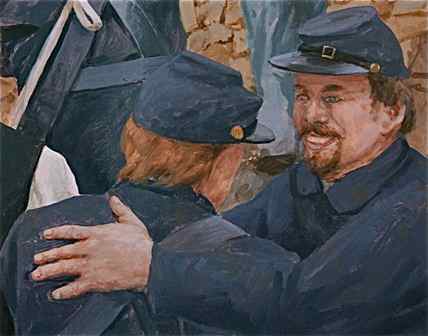
Again in “Rescue at Leasburg," are these two soldiers congratulating one another on a well fought battle?
Those are the pictures within the pictures that I see. How about you?
*********
Viva Cuba thanks Jenny Gross for her unique take on the Civil War Murals. If you would like to refresh your memory of the whole mural panels again, visit Viva Cuba’s website.
Perhaps the artist Don Gray who has relocated to Oregon from California will let us know what he thought as he painted these scenes of emotion and challenge. Whether you are looking at the whole or the “pictures within the of the pictures,” they have drawn many tourists and locals to study them and think about the history and people who made it.




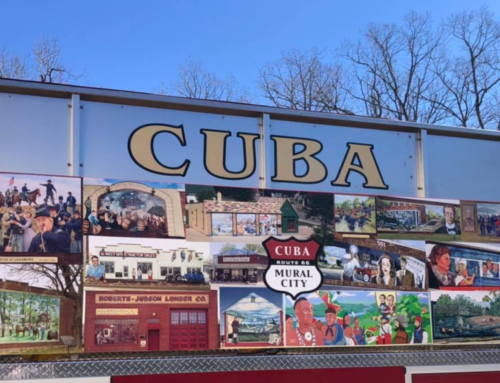

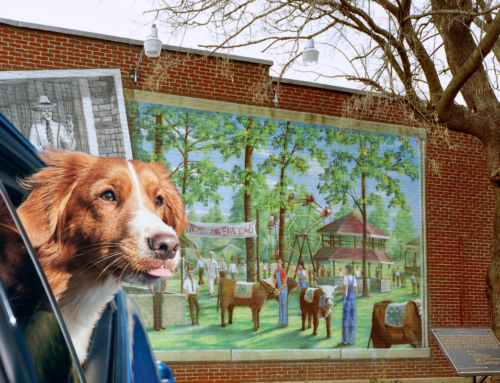


Hi Jenny,
Thanks so much for your careful study of my Civil War murals–I appreciate your thoughtful insights. I’ll try to respond to your commentary about the images.
You’re right about the “Destroying the Fort” soldier–perhaps he looks a little too serene for the chaos that is all around him. My weak defense is that different people react differently to stress (I know, it’s a cop-out.:)
In the Huzzah water crossing, I tried to imagine how it would feel–I think you’ve got it exactly right about one glancing back in fear while the other forges on, his mind focused on gaining the shore and safety. The exhausted soldier has almost run out of energy, stumbling on the slippery creek bottom.
In the “Rescue at Leasburg panel, I wanted to depict the cross-section of people involved in this event. There were over 100 civilians from the town of Pilot Knob who were in the fort and went on the grueling forced march with the troops. I tried to depict the joy and relief they felt on finally being rescued from their ordeal. I would imagine that some hugged the soldiers for protecting them. The solitary soldier could indeed be giving thanks, or perhaps crying at the release of the strain.
I’m pleased that you took the time to do this, Jenny–thanks.
Don Gray
Don,
Thank you for sharing your insights about these wonderful pieces. I must say, I wasn’t expecting your response to my assessment of the soldier in ‘Destroying the Fort’. I disagree with your thought that he is possibly “too serene for the chaos”. Here’s my reasoning. The Battle of Pilot Knob was fought in 1864, three years into the War. After all that time wouldn’t it be understandable that a soldier could be serene as fire and debris rained down upon him? I imagine after all the battles and horrors of war these explosions and scenes of chaos became the norm. So, in reality calm would be a perfect emotion for this soldier.
Regarding the civilians in ‘Rescue at Leasburg’, now it makes perfect sense. As for the solitary soldier; I believe he can give you a range of emotions, but it all depends upon how and where you see him within the work. I realized this when you mentioned him “crying at the release of the strain”. When I shot my original photo it was a wider view than what I used in the blog. There you could see him on bended knee as if in prayer. When I reviewed the cropped imagine in the piece I agree, he could also be crying. It would be interesting to know what others see in him.
I’m thankful to have been given this opportunity to share my thoughts and images. I appreciate your feedback.
Thank you for creating this wonderful artwork.
Jenny Gross